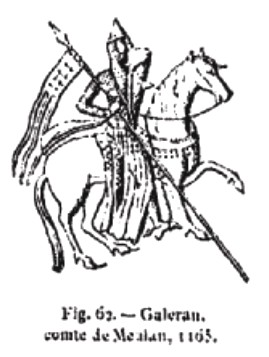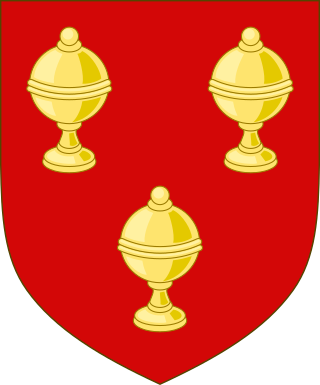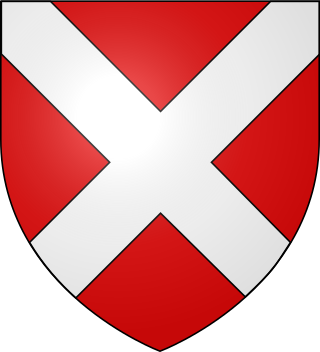Related Research Articles
The peerage title Earl of Kent has been created eight times in the Peerage of England and once in the Peerage of the United Kingdom. In fiction, the Earl of Kent is also known as a prominent supporting character in William Shakespeare's tragedy King Lear.

Roger Mortimer, 3rd Baron Mortimer of Wigmore, 1st Earl of March, was an English nobleman and powerful Marcher Lord who gained many estates in the Welsh Marches and Ireland following his advantageous marriage to the wealthy heiress Joan de Geneville, 2nd Baroness Geneville. Her mother was of the Royal House of Lusignan.

Earl of March is a title that has been created several times in the Peerage of Scotland and the Peerage of England. The title derived from the "marches" or borderlands between England and either Wales or Scotland, and it was held by several great feudal families which owned lands in those districts. Later, however, the title came to be granted as an honorary dignity, and ceased to carry any associated power in the marches.

Baron Burgh is a title that has been created twice in the Peerage of England.

Baron Stafford, referring to the town of Stafford, is a title that has been created several times in the Peerage of England. In the 14th century, the barons of the first creation were made earls. Those of the fifth creation, in the 17th century, became first viscounts and then earls. Since 1913, the title has been held by the Fitzherbert family.

Baron le Despencer is a title that has been created several times by writ in the Peerage of England.

Sir Roger de Mortimer, 2nd Earl of March, 4th Baron Mortimer of Wigmore, KG was an English nobleman and military commander during the Hundred Years' War.

Baron Hungerford is a title in the Peerage of England. It was created on 7 January 1426 for Walter Hungerford, who was summoned to parliament, had been Member of Parliament, Speaker of the House and invested as Knight of the Order of the Garter before and was made Lord High Treasurer one year before he became a peer. The man who would later succeed as third baron was created Baron de Moleyns on 13 January 1445 by writ of summons; both titles merged when he succeeded as Baron Hungerford in 1459. The third baron was attainted and the peerage forfeit in 1461. This attainder was reversed in 1485 for the then 4th baroness of Hungerford, and so it came into the Hastings family of Earls of Huntingdon until 1789, when it came into the Rawdon(-Hastings) family of the Marquesses of Hastings until 1868 when it fell into abeyance. This abeyance was terminated three years later for a member of the Abney-Hastings family and an Earl of Loudoun. In 1920 it again fell into abeyance, which was terminated one year later for the Philipps family of the Viscounts of St Davids where it has remained since.

Earl of Worcester is a title that has been created five times in the Peerage of England.

The peerage title Earl of Ormond and the related titles Duke of Ormonde and Marquess of Ormonde have a long and complex history. An earldom of Ormond has been created three times in the Peerage of Ireland.

Edmund Mortimer, 2nd Baron Mortimer of Wigmore was the second son and eventual heir of Roger Mortimer, 1st Baron Mortimer of Wigmore. His mother was Maud de Braose.

Baron Neville or Nevill was a title of nobility in England, relating to and held by the Neville family, a noble house in northern England. The Nevilles had their family seat at the manor of Raby in County Durham, and so were called barons "Neville of Raby". The title was first held as a barony by tenure, and was afterwards created twice by writ of summons to parliament.
There have been two creations of the title Baron Raby, both in the Peerage of England. The first was in 1640, as a subsidiary title of the Earl of Strafford. The first earl was attainted and his peerages declared forfeit in 1641, but his heir obtained a reversal in 1662. On his death, all his peerages became extinct save the Barony of Raby, which continued until the death of the fifth baron in 1799. Confusingly, the third baron was again created Earl of Strafford in 1711, and the earldom and barony remained merged until their mutual extinction.
The title Baron Ferrers of Chartley was created on 6 February 1299 for John de Ferrers, son of Robert de Ferrers, 6th Earl of Derby. The daughter of the 6th Baron Ferrers of Chartley, Anne, married Walter Devereux who was summoned to parliament as Lord Ferrers in her right. Their descendants became Earls of Essex and the peerage was forfeited in 1601 on the attainder of Robert Devereux, 2nd Earl of Essex, but restored to his son Robert in 1604, on whose death in 1646 the peerage fell into abeyance. The abeyance was terminated in 1677 when Robert Shirley, a grandson of one of the sisters of the 3rd Earl of Essex, was summoned as Lord Ferrers of Chartley with precedence to the original creation. In 1711, Shirley was created the 1st Earl Ferrers, but the Earldom and Barony separated at his death, the barony going to Elizabeth Shirley, the daughter of his eldest son, while the earldom went to his second son. On the 1741 death of Elizabeth Shirley, 15th Baroness Ferrers of Chartley and wife of the Earl of Northampton, the peerage again briefly fell into an abeyance that was resolved in 1749 by the death of two of the three heiresses, leaving the surviving daughter, Charlotte Compton, wife of the Marquess Townshend, as 16th Baroness Ferrers of Chartley. The barony continued, merged with the marquessate, until the death of George Ferrars Townshend, 3rd Marquess Townshend in 1855, when it again fell into abeyance between his two sisters and their heirs. It remains in abeyance.
James Butler, 1st Earl of Ormond, was a noble in the Peerage of Ireland. He was born in Arklow, Wicklow, Ireland and died in Gowran, Kilkenny, Ireland.

Several members of the Mortimer family were summoned to Parliament during the reign of Edward I, thereby making them hereditary barons in the Peerage of England. The most important family with this surname were the lords of Wigmore, a marcher lordship on the borders of Herefordshire and Shropshire with Wales, living at Wigmore Castle. The second Baron Mortimer of Wigmore was created Earl of March.

The titles Baron Montacute or Baron Montagu were created several times in the Peerage of England for members of the House of Montagu. The family name was Latinised to de Monte Acuto, meaning "from the sharp mountain"; the French form is an ancient spelling of mont aigu, with identical meaning.
The title Baron Badlesmere was created once in the Peerage of England. On 26 October 1309 Bartholomew de Badlesmere, Governor of Bristol Castle, was summoned to Parliament, creating a barony by writ. In 1322, he was attainted and executed for joining the rebellion of the Earl of Lancaster, and the barony was forfeited. In 1328, the attainder was reversed for his heir, Giles de Badlesmere, his only son. On the death of the 2nd Baron in 1338, however, the barony became abeyant between his sisters. The eldest line of these follows the same line as that of the Baron de Ros.
Joan de Geneville, 2nd Baroness Geneville, Countess of March, Baroness Mortimer, also known as Jeanne de Joinville, was the daughter of Sir Piers de Geneville and Joan of Lusignan. She inherited the estates of her grandparents, Geoffrey de Geneville, 1st Baron Geneville, and Maud de Lacy, Baroness Geneville. She was one of the wealthiest heiresses in the Welsh Marches and County Meath, Ireland. She was the wife of Roger Mortimer, 1st Earl of March, the de facto ruler of England from 1327 to 1330. She succeeded as suo jure 2nd Baroness Geneville on 21 October 1314 upon the death of her grandfather, Geoffrey de Geneville.
Sir Edmund Mortimer was the eldest son of Roger Mortimer, 1st Earl of March, and Joan de Geneville, 2nd Baroness Geneville. By his wife Elizabeth de Badlesmere he was the father of Roger Mortimer, 2nd Earl of March. Though Edmund survived his father by one year, he did not inherit his father's lands and titles as they were forfeited to the Crown and his son only reacquired them gradually.